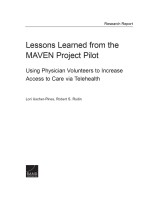| 来源类型 | Research Reports
|
| 规范类型 | 报告
|
| DOI | https://doi.org/10.7249/RR1753
|
| ISBN | 9780833097033
|
| 来源ID | RR-1753-CAHF
|
| Lessons Learned from the MAVEN Project Pilot: Using Physician Volunteers to Increase Access to Care via Telehealth |
| Lori Uscher-Pines; Robert S. Rudin
|
| 发表日期 | 2016
|
| 出版年 | 2016
|
| 页码 | 31
|
| 语种 | 英语
|
| 结论 |
When Volunteers Were Engaged, Patients Benefited in Multiple Ways- Volunteers often reassured patients.
- Patients could avoid costly and inconvenient travel to an in-person specialist or could be seen by an in-person specialist more quickly.
Volunteers Generally Evaluated the Program Positively Overall- Volunteers were very pleased with administrative staff and the improvements made to the pilot over time.
The On-Site Clinicians Had Only Positive Things to Say About the Physician Volunteers- They frequently praised their clinical skill and professionalism.
Low Utilization of Volunteers by On-Site Clinic Providers Was a Leading Challenge- Some on-site physicians and volunteers identified cases in which referral to MAVEN Project volunteers was inappropriate.
- Lack of familiarity and rapport between on-site clinicians and volunteers was a major barrier to uptake.
- The limited hours of MAVEN Project volunteers and the need to track the schedules of part-time volunteers were barriers to greater uptake.
Workflow Issues Are Common in New Telehealth Interventions- Each service line required its own unique workflow; there was no one-size-fits-all approach.
- Both volunteers and on-site staff independently recommended that certain days or blocks of time be fully dedicated to the MAVEN Project and telehealth.
Volunteers Did Not Always Get Information on What Ultimately Happened to Their Patients- They were concerned that, given the low volume of visits, there might be insufficient demand to allow them to meet their personal goals with the program and to remain comfortable with MAVEN Project systems and processes.
The Program Can Have Unintended Consequences- Certain patients who confront barriers to in-person care might opt to use the MAVEN Project as a substitute for the care of a local specialist.
|
| 摘要 |
- Consider developing standardized criteria for referrals and conducting collaborative training sessions about referral decisions with on-site staff and volunteers.
- Prior to implementing a particular service at each site, write the goal statement for that unique offering that takes into account patient acuity, the "telehealthabilty" of the service line, and the state of local specialty care.
- Facilitate more in-person interaction between volunteers and on-site clinicians prior to launching a service line.
- Consider experimenting with a panel of volunteers in which all specialties or a subset of specialties are available 24/7 for curbside consults via mobile phone.
- Initially focus on a narrower set of specialties, such as hematology, rheumatology, and cardiology, and develop workflow models for each one.
- Encourage clinics that are not already doing so to establish a block of MAVEN Project appointments in which on-site providers are fully dedicated to the MAVEN Project.
- In workflow models for direct patient care, consider integrating some time for dedicated provider-to-provider communication.
- Consider developing a feedback mechanism or process for volunteers to track patients' outcomes and see the results of their work.
- Request and monitor that volunteers do a certain number of visits per week or month to maintain interest and competency in the program.
- Train volunteers on proper conduct in telehealth visits using materials developed by professional associations and telehealth companies.
- Assess inappropriate use of the MAVEN Project by patients.
|
| 主题 | Health Care Access
; Health Care Program Evaluation
; Physicians
; Telemedicine
|
| URL | https://www.rand.org/pubs/research_reports/RR1753.html
|
| 来源智库 | RAND Corporation (United States)
|
| 引用统计 |
|
| 资源类型 | 智库出版物
|
| 条目标识符 | http://119.78.100.153/handle/2XGU8XDN/108423
|
推荐引用方式
GB/T 7714 |
Lori Uscher-Pines,Robert S. Rudin. Lessons Learned from the MAVEN Project Pilot: Using Physician Volunteers to Increase Access to Care via Telehealth. 2016.
|
|
文件名:
|
x1535053747977.jpg
|
|
格式:
|
JPEG
|

|
文件名:
|
RAND_RR1753.pdf
|
|
格式:
|
Adobe PDF
|
除非特别说明,本系统中所有内容都受版权保护,并保留所有权利。